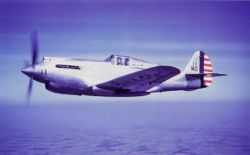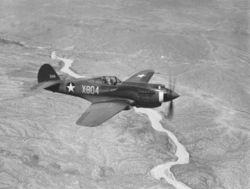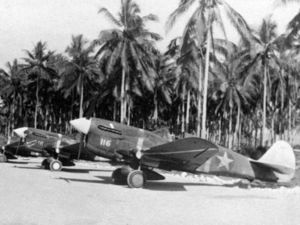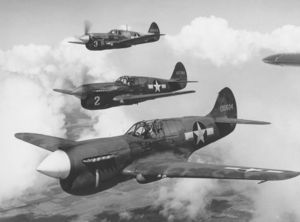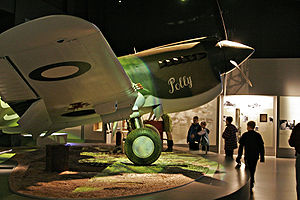PlaneSpottingWorld welcomes all new members! Please gives your ideas at the Terminal.
P-40 Warhawk
| P-40 Warhawk | |
|---|---|
| USAAF P-40K with "shark mouth" nose art. | |
| Type | Fighter aircraft |
| Manufacturer | Curtiss-Wright Corporation |
| Maiden flight | 1938 |
| Retired | 1948 (USAF) |
| Primary users | U.S. Army Air Force Royal Air Force American Volunteer Group Many others |
| Produced | 1939-1944 |
| Number built | 13,738 |
| Unit cost | US$60,552[1] |
| Developed from | Curtiss P-36 |
| Variants | Curtiss XP-46 |
The Curtiss P-40 was a US single-engine, single-seat, low-wing, all-metal fighter and ground attack aircraft which first flew in 1938, and was used in great numbers in World War II. It was a direct adaptation of the existing P-36 airframe to enable mass production of first-line fighters without significant development time. When production ceased in November 1944, 13,738 P-40s had been produced; they were used by the air forces of 28 nations and remained operational throughout the war.
Warhawk was the name the United States Army Air Corps adopted for all models, making it the official name in the United States for all P-40s. British Commonwealth air forces gave the name Tomahawk to models equivalent to the P-40B and P-40C and the name Kittyhawk to models equivalent to the P-40E and all later versions.
The P-40's lack of a two-stage supercharger made it inferior to Luftwaffe fighters in high altitude combat, and as such the P-40 was rarely used in operations in Northwest Europe. However, between 1941 and 1944, the P-40 played a critical role with Allied air forces in five major theaters around the world: China, the Mediterranean Theater, the South East Asian Theater, the South West Pacific Area and in Eastern Europe.
P-40s first saw action with British Commonwealth air forces in the Desert Air Force, in August 1941.[2] The P-40's poor high-altitude performance was not a detriment in the North African Campaign where its bomb load, armour and good range were beneficial. The Royal Air Force's No. 112 Squadron was the first to fly Tomahawks in North Africa. The squadron copied the famous shark mouth markings from Luftwaffe Messerschmitt Me 110 Zerstörer units with the logo later adopted by the Flying Tigers in China for their P-40s.
Contents
- 1 Design and development
- 2 Operational history
- 3 Variants and design stages
- 4 Famous P-40 pilots
- 5 Operators
- 6 Specifications (P-40E)
- 7 Popular culture
- 8 References
- 9 External links
- 10 Related content
Design and development
The prototype XP-40 was actually a Curtiss P-36 Hawk with its Pratt & Whitney R-1830 (civilian name, Twin Wasp) radial engine replaced by a liquid-cooled, supercharged Allison V-1710 V-12 engine. The "V-12" engine offered no more power than the radial, but its smaller frontal area reduced drag.
Performance characteristics
The P-40 had good agility, especially at high speed. It was one of the tightest-turning monoplane fighters of the war,[3] although at lower speeds it was not comparable to highly maneuverable Japanese fighters such as the A6M Zero and Ki-43.[4]
Allison V-1710 engines were not powerful by the standards of the time, and the P-40's speed was average. Its climb performance was fair to poor, depending on the subtype.[4] Dive acceleration was good and dive speed excellent.[4] However the single-stage, single-speed supercharger meant that it could not compete with modern enemy or allied—types as a high-altitude fighter.
It was a fairly simple aircraft, lacking such sophisticated innovations as boosted ailerons or automatic leading edge slats, but it had a very strong structure including a seven-longeron wing which enabled P-40s to survive several documented partial mid-air collisions with enemy aircraft (some of these were recorded as victories by the RAF and VVS).[5]
Operational range was good by early war standards, almost double that of the Supermarine Spitfire or Bf 109 for example, though inferior to the A6M Zero and the Ki-43, or the late-war P-38 Lightning and P-51 Mustang.
Visibility was adequate, although hampered by an overly complex frame and completely blocked to the rear in early models. Poor ground visibility and the relatively narrow undercarriage and wheels led to many losses due to accidents on the ground.[4]
It was also fairly heavily armed and armored. The P-40 could carry a moderately effective air-to-ground load (although it was never fitted with rockets), was semi-modular and thus easy to maintain in the field, and tolerated harsh conditions, fighting everywhere from the deserts of North Africa, to the jungles of New Guinea and the Dutch East Indies, to the Arctic climes of the Soviet Union and Alaska.
Like the P-39 Airacobra, many Army Air Forces officials considered the P-40 inferior; it was unpopular with some United States pilots in the Pacific.[citation needed] Its gradual replacement by the turbo-supercharged P-38 was greeted with relief. However, the bulk of the fighting conducted by the USAAF during the height of Axis power in 1942-1943 was borne by the P-40 (and the P-39,) and it was these two Army Air Force fighters, along with the Navy's F4F Wildcat, which contributed most among US types to breaking Axis air-power during this critical period, especially in the Pacific. In this stop-gap role fighting in nearly every theater and under every allied flag, the P-40 offered the additional advantage of a low price tag, which kept it in production as a tactical (ground-attack) fighter long after it was obsolete as an air-superiority type.
In theaters where the high-altitude characteristics were less important, the P-40 still proved considerably more effective as a fighter. Although it gained a postwar reputation as a mediocre type suitable only for close air support, more recent data from Allied squadrons in particular indicate that the P-40 performed surprisingly well as an air-superiority fighter, at times, suffering severe losses but also taking a very heavy toll on enemy aircraft.[4]
Operational history
In April 1939, the Army Air Corps, witnessing the new sleek, high-speed, in-line-engined fighters of the European air forces, placed the largest single fighter order it had ever made for fighters: 524 aircraft.
French Air Force
An early order came from the French Armée de l'Air, which was already operating P-36s. The Armée de l'Air ordered 140 as the Hawk 81A-1 but the French military had been defeated before the aircraft had left the factory, consequently, the aircraft were diverted to British Commonwealth service (as the Tomahawk I), in some cases, complete with metric instruments.
In late 1942, as French forces in North Africa split from the Vichy government to side with the Allies, US forces transferred P-40Fs to the GC II/5, a squadron that was historically associated with the Lafayette Escadrille. GC II/5 used its P-40Fs and Ls in combat in Tunisia, and, later for patrol duty off the Mediterranean coast, until mid-1944 when they were replaced by P-47Ds.
Royal Air Force/Desert Air Force
In all, 12 British Royal Air Force squadrons, as well as two South African Air Force and two Royal Australian Air Force (RAAF) squadrons serving with the RAF used 930 P-40s. (The British government also donated 23 P-40s to the Soviet Air Force.)
The P-40B/C "Tomahawk" was deemed unsuitable for combat in the European theater, and was eventually relegated to North Africa. Entering combat in August of 1941, the Tomahawks initially proved quite effective against Axis aircraft and contributed to a slight shift of momentum in the Allied favor. It was countered by the gradual introduction of the new, very formidable "Friedrich" (Bf 109F) variant of the Bf 109.
The Tomahawk was superceeded by the more powerful P-40D/E/K "Kittyhawk" types beginning in 1942, though the older Tomahawks remained in service until 1943. The formidable Kittyhawk variant of the P-40 (later known as the "Kittybomber" when used in the fighter-bomber role) was a major improvement over the earlier Tomahawk, and actually became the RAF's primary air superiority type in Theater for the first six months of 1942, until it was finally replaced by sufficient numbers of tropicalized Spitfire Mark Vs. Commonwealth units in North Africa received few of the more powerful Packard built Merlin-engined P-40F/Ls (Kittyhawk IIA), most of which went to the USAAF. The RAF's desire for a Merlin-engined version of the P-40 ultimately led to the design of the P-51 Mustang. The later P-40M and much improved N versions arrived later and saw use mostly in the fighter-bomber role.
Tomahawk and Kittyhawk squadrons bore the brunt of the Luftwaffe and the Regia Aeronautica onslaught in North Africa in the crucial years of 1941 and 1942, playing a critical role in the North African campaign. Because most of the air combat took place well within the performance envelope of the P-40 (below 16,000 feet), in the hands of competent pilots the P-40 proved effective against even the best of the Luftwaffe and Regia Aeronautica.[4][6] Considered markedly superior to the older Hawker Hurricane which it replaced as the primary fighter of the Desert Air Force,[4] the P-40 was deadly against Axis bombers in theater, and dominated the Bf 110 and the early Italian fighter types such as the Fiat G.50 and the Macchi C.200, though the Bf 109 proved a greater challenge, particularly the later F and G variants. The P-40 was at least equal in firepower to the 109, superior in maneuverability and of a much stronger overall structure, but inferior in climb and (somewhat less) in speed.[4] P-40s also eventually faced the Fw 190 and several much-improved late Italian fighter types such as the excellent Macchi MC.202 and Macchi MC.205, the Reggiane Re.2000 / 2001 / 2005 and the superlative Fiat G.55 which were superior in many aspects, especially top speed.
In escort, fighter sweep, and combat air patrol missions P-40s continued to give a generally good account of themselves however, with 46 British Commonwealth pilots reaching ace (five or more kills) in P-40s, including seven double aces.[6] But as P-40 squadrons began to fly more close air support missions, losses rose dramatically. Many Tomahawks and Kittyhawks were caught low and slow by marauding Bf 109s, flown by the veteran pilots of elite Luftwaffe units such as the famous Jagdgeschwader 27 and the Allied squadrons suffered heavy casualties.
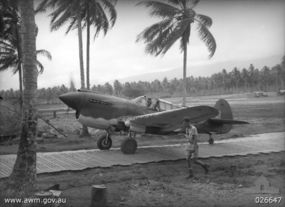
In addition, some Commonwealth units, in particular the South African squadrons, are alleged to have utilized poor tactics — such as the defensive Lufbery circle — and suffered even higher attrition rates as a result. German aces made good use of the superior climb rate of the Bf 109 and specialized in destroying Allied fighter aircraft in slashing vertical attacks. Most notable was fighter ace Hans-Joachim Marseille who may have destroyed as many as 70 P-40 fighters in his career before losing his life in a noncombat accident.[7] However, some researchers have suggested that German pilots in North Africa over-reported kills,[8] due in part to the German practice at the time of rewarding aces according to the number claimed.
It is clear that a capable and experienced pilot, able to use the P-40 to its utmost, could fare well against the best Luftwaffe pilots flying the finest German aircraft. For example, the most successful Australian ace of the war, Clive "Killer" Caldwell, scored most of his victories flying Tomahawks and Kittyhawks with the RAF's 112 and 250 Squadrons in North Africa. On 29 August 1941, while on a mission over northwest Egypt, Caldwell became separated from other members of his squadron and was returning to base. He was attacked by two Bf 109s, one of them the Bf 109E-7 "Black 8" of one of Germany's top aces, Werner Schroer—who would be credited with 114 Allied planes in only 197 combat missions. Although Caldwell's Tomahawk was hit by more than 100 7.9 mm bullets and five 20 mm cannon shells, he destroyed the Bf 109 accompanying Schroer and heavily damaged "Black 8," forcing Schroer to disengage. Caldwell is also believed to have killed another German ace, Erbo Graf von Kageneck (69 kills).[9] While flying P-40s, Caldwell achieved 22 victories, 10 of which were Bf 109s and two Macchi C.202s. (He later achieved another 6.5 victories flying Spitfires in the Pacific.)[10] Canadian pilot James "Stocky" Edwards, who achieved 13 kills in the P-40 with the RAF's 94 and 260 Squadrons in North Africa, shot down German ace Otto Schulz (51 kills) while flying a Kittyhawk. Edwards and Caldwell were only two of at least a dozen pilots of several different Allied nations who achieved ace status two or more times over (ten or more kills) while flying the P-40.[6][11]
Royal Australian Air Force
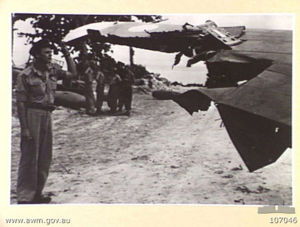
The Kittyhawk was the main fighter used by the RAAF in World War II, ahead of the Spitfire. Two RAAF squadrons serving with the Desert Air Force, No. 3 and No. 450 Squadrons, were the first Australian units to be assigned P-40s. Other Australians served with RAF Squadrons in the theater.
Many RAAF pilots achieved high scores in the P-40 (some while flying for the RAF early in the war), at least five reaching double-ace status: Caldwell (22 kills), Barr (11 kills) and Gibbs (ten kills) in North Africa, Whittle and Waddy (11 kills each) in North Africa and New Guinea. In all, 18 RAAF pilots became aces while flying P-40s.[6]
At the same time as the heaviest fighting in North Africa, the Pacific War was also in its early stages, and RAAF units in Australia were completely lacking in state-of-the-art fighters. Spitfire production was being absorbed by the war in Europe, Mustangs had not yet reached squadrons anywhere and Australia's tiny and inexperienced aircraft industry was geared towards larger planes. US-built P-40s were seen as the main solution to this problem. During the course of the war, the RAAF ordered 880 Kittyhawks for use in the South West Pacific Area. The P-40 fought on the front line as a fighter during the critical early years of the war in the Pacific in 1942 and 1943, and later the durability and bomb-carrying abilities of the P-40 made it ideal for the close air support role until the end of the war.
A small force of RAAF Kittyhawks from No.s 75, and 76 squadrons played a critical role in the Australian war effort during the Battle of Milne Bay [12]. The Kittyhawks of No. 75 and 76 squadron successfully fended off Japanese aircraft and performed effective close air support for the Australian and U.S. troops, largely negating the initial Japanese advantage in light tanks and sea power.
The RAAF units which made the most use of Kittyhawks were: No. 75 Squadron RAAF, No. 76 Squadron RAAF, 77, 78, 80, 82, 84, 86 and No. 120 (Netherlands East Indies) Squadron (an RAAF unit recruited from Dutch fliers). Kittyhawks from 75 and 76 Squadrons were instrumental in the historic defeat of Japanese ground forces at the Battle of Milne Bay.
Late in 1945, RAAF fighter squadrons began converting to P-51Ds. However, Kittyhawks were in use with the RAAF until the very last day of the war in the Borneo campaign.
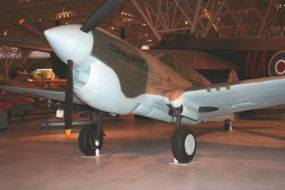
Royal Canadian Air Force
In mid-May 1940, Canada had its first look at the Curtiss P-40. At that time a party of American officers flew to Uplands Airport near Ottawa where they saw the XP-40 and a Spitfire I flown in comparative tests. When Canadian army requirements for France were drawn up, one of the units was to have been an Army Co-operation Wing (No. 101) consisting of three squadrons: No. 400 (previously 110) Squadron and No. 414 Squadron, equipped with P-40 Tomahawk aircraft, formed No. 39 (AC) Wing (RCAF). By January 1943, all three squadrons had transitioned to the Mustang Mk I. In all, the RCAF received 72 Kittyhawk I, 12 Kittyhawk Ia, 15 Kittyhawk III and 35 Kittyhawk IV aircraft, for a total of 134 aircraft, plus the loan of nine Warhawks (P-40Ks) in the Aleutians, all in lieu of the 144 P-39 Airacobras originally allotted to Canada and rejected.
One of the most significant uses of the RCAF P-40 occurred in the 1942 Aleutian Campaign. When the Japanese navy moved to attack Midway, they sent a diversionary battle group to attack the Aleutian Islands. Canada moved No. 111 Squadron, flying Kittyhawk 1s to Alaska to help defend the region from a forward base on Adak Island. During the drawn-out campaign, 12 Canadian Kittyhawks would operate on a rotational basis from a new, more advanced base on Amchitka, 75 miles southeast of Kiska. Two RCAF fighter squadrons took "turn-about," No. 111 and No. 14. After the Japanese threat diminished, the unit returned to Canada and eventually transferred to England without its Kittyhawks. One A6M2-N "Rufe" was shot down by RCAF S/L Boomer.
Royal New Zealand Air Force
A total of 301 P-40s were allocated to the Royal New Zealand Air Force under lend lease, 297 seeing service, (the remaining 4 being lost on delivery). These aircraft equipped 14 Squadron, 15 Squadron, 16 Squadron, 17 Squadron, 18 Squadron, 19 Squadron, and 20 Squadron. Some RNZAF pilots in North Africa and Italy also flew British P-40s while serving with RAF squadrons.
RNZAF P-40s were successful in air combat against the Japanese during intense fighting in the Pacific Ocean Areas theatre from 1942 until 1944, when they were replaced by F4Us. New Zealand pilots claimed 99 aerial victories in P-40s, losing 20 aircraft in aerial combat. Geoff Fisken, the Commonwealth's highest scoring flying ace in the Pacific, flew P-40s with No. 15 Squadron RNZAF, although half his victories came on the Brewster Buffalo.
From late 1943 and 1944, RNZAF P-40s were increasingly used against ground targets. The last frontline RNZAF P-40s were replaced by F4U Corsairs in 1944, with P-40s relegated to use as advanced pilot trainers.[13][14][15]
Remaining RNZAF P-40s, excluding the 20 shot down and 154 written off, were mostly scrapped at Rukuhia in 1948. At least six RNZAF P-40s have survived. Fisken's machine is owned by The Old Stick and Rudder Company (OSRC) and is currently being restored in New Zealand.[16] Three are currently airworthy: NZ3009 with the OSRC, whilst NZ3094 and NZ3125 are flying in Australia. Other New Zealand P-40s are on display at the Museum of Transport and Technology in Auckland and under restoration at the Royal New Zealand Air Force Museum in Christchurch. The remains of two others are part of a private collection in New Zealand.
Chinese Air Force/Flying Tigers (American Volunteer Group)
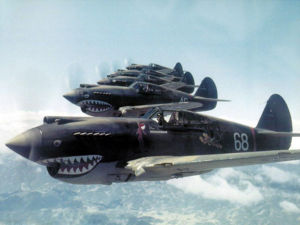
The Flying Tigers known officially as the American Volunteer Group, were a unit of the Republic of China Air Force, and were led by a retired Army Air Force officer and military observer Claire Chennault. From late 1941, the P-40 was the fighter used by the Flying Tigers.
Compared to opposing Japanese fighters, the P-40's strengths were that it was very sturdy, heavily armed, generally faster in a dive and possessed a good rate of roll.[17] While the P-40 could not match the maneuverability of the Japanese Nakajima Ki-27 and Nakajima Ki-43 monoplanes they were facing, Chennault trained the AVG pilots to use the performance advantage the P-40 held over the Japanese fighters to gain the upper hand in combat. The P-40 had a higher dive speed than the Japanese fighters, for example, and would often be used with so-called "boom-and-zoom" tactics. The AVG was highly successful, and accordingly, their exploits were widely published in order to boost the morale of the American public. According to the American count, the Flying Tigers were credited with destroying 297 aircraft in the air and on the ground for the loss of only 21 pilots and their aircraft. Alternative counts have been as low as 115-21, but never any lower.
United States Army Air Forces
A P-40C of the 33rd Fighter Squadron, flown by 2nd Lt. Joseph D. Shaffer and based at Reykjavík, Iceland, shared credit for the first victory over a German aircraft by the USAAF in World War II. A Fw 200C-3 bomber overflew the base on August 14, 1942 and was destroyed by Shaffer and a P-38F of the 1st Fighter Group.
South West Pacific Area
In the first major battles at Pearl Harbor, the Philippines and in the Dutch East Indies, USAAF P-40 squadrons were massacred on the ground and slaughtered in the air by Japanese fighters like the Ki-43 "Oscar" and the A6M Zero. But in later battles, improved tactics and training allowed the strengths of the aircraft to be more effectively utilized, enabling often-outnmbered P-40 squadrons to hang on against heavy odds and eventually triumph over the IJN and the JAAF.
The 49th Fighter Group was one of the most important US fighter groups in the South West Pacific, in action from the beginning of the war to the very end, playing a key role in the defense of Darwin, Australia and Port Morseby, New Guinea. The 49th flew P-40s until they were replaced by P-38s in 1944.
Robert Marshall DeHaven was an ace with the 49th FG, scoring 10 kills in the P-40, 14 kills overall. He compared the P-40 to the P-38:
- "If you flew wisely, the P-40 was a very capable aircraft. In many conditions, it could outturn a P-38, a fact that some pilots didn't realize when they made the transition between the two aircraft. The P-40 kept me alive and allowed me to accomplish my mission. The real problem with it was lack of range. As we pushed the Japanese back, P-40 pilots were slowly left out of the war. So when I moved to P-38s, an excellent aircraft, I did so not because I believed that the P-40 was an inferior fighter, but because I knew the P-38 would allow us to reach the enemy. I was a fighter pilot and that was what I was supposed to do." [18]
China Burma India Theater
The P-40 performed extremely well in this theater, scoring high kill ratios against Japanese Army types such as the Nakajima Ki-43 Hayabusa ("Oscar" to the Allies), Nakajima Ki-44Shoki ("Tojo" to the Allies) and even Navy types like the A6M Zero throughout the war. The P-40 remained in use in the CBI until 1944 and was reportedly preferred over the P-51 Mustang by some U.S. pilots flying in China.
At least 40 US Pilots reached Ace status flying the P-40 in the CBI.[11]
The American Volunteer Group (Flying Tigers) were integrated into the USAAF as the 23rd Fighter Group. The unit continued to fly P-40s (of newer models) until the end of the war, racking up a high kill-to-loss ratio.[19][11]
Mediterranean theater
Though the P-40 suffered heavy loses in the Mediterranean Theater of Operations (MTO), many US P-40 units had good combat records in the theater, racking up high kill to loss ratios against the Germans and Italians. For example the 324th Fighter Group scored better than a 2:1 ratio while fighting in the (MTO).[3] In all, 23 US pilots became aces in the MTO while flying the P-40, most during a fairly short period during the first half of 1943.[20] As in the Pacific, success in combat seemed to largely be a matter of experience and effective tactics. It is also worth noting that like the Soviets, many United States pilots stripped down their P-40s to improve performance, often even removing two or more of the wing guns from their P-40F/L Warhawks. It was also in this theater that the lightened P-40L (which also had some wing guns removed) was most heavily used, primarily by U.S. pilots.
Some of the first Army Air Force P-40s used in this theater were launched from aircraft carriers during Operation Torch, to land on freshly captured Vichy French airfields. This was one of the very rare examples of land based planes being deployed from a carrier, another being Jimmy Doolittle's famous B-25 raid on Tokyo.
The 57th Fighter Group was equipped with the Curtiss fighter until early 1944, during which time they were credited with at least 140 air-to-air kills. It was the 57th that took part in the "Palm Sunday Massacre" which took place on April 18, 1943. On this day, decoded Ultra ciphers had given away a Luftwaffe plan to cross the Mediterranean Sea with a large formation of German transport planes (Junkers Ju 52) and their escorts (Bf-109s). An ambush was laid for them with three squadrons of the 57th, one squadron from the 324th Fighter Group (also flying P-40s) and a small group of British Spitfires intercepting the German formation and shooting down at least 70 German planes with only six or seven Allied airplanes being downed.[20]
The 325th Fighter Group, better known as the "Checkertail Clan", also fought in the MTO. While flying the P-40, the three squadrons of the 325th were credited with at least 133 air-to-air kills while flying the P-40 from April to October 1943, of which 95 victories were Bf 109s and 26 were the superior Macchi C.202, for the loss of only 17 P-40s in combat.[21][20] One incident with the 325 FG indicates what could happen if Bf 109 pilots made the mistake of trying to turn-fight with the P-40.
On 30 July 20 P-40s of the 317th and 16 P-40s of the 319th Squadron took off on a fighter sweep, to rendezvous over Sardinia. As they turned to fly south over the west part of the island, they were attacked near Sassari and 20 miles north of the rendezvous point where they were to meet the 319th coming from the east. The attacking force consisted of 25 to 30 Bf 109s and Macchi C.202s, bringing the estimated total of enemy aircraft engaged to between 40 and 50 planes. Radio communications with the other squadron was poor and repeated inquiries received no answers, so the 319th was unable to locate the battle. In the brief, intense battle that occurred, 20 P-40s engaged and destroyed 21 enemy aircraft. General observations on the encounter show that in addition to the 21 victories and four probables reported, there may have been many more. It is believed that Lt. Robert Sederberg, who singly went to the aid of a fellow pilot who was being attacked by five Bf 109s, in addition to destroying one Me-109 for sure, scored at least four victories. Lt. Sederberg was last seen engaged in combat with five Bf 109s. Many months later, he was reported a prisoner of war in Germany.
As combat waned in North Africa, the 325th moved on to Sardinia, then Sicily and finally Italy, transitioning to P-47 Thunderbolts and later to P-51 Mustangs, continuing to increase their excellent victory totals against the Luftwaffe.
Soviet Union
Though only moderately popular with the Soviets, the Soviet Air Force used the relatively few P-40s they had been given quite extensively against the Germans on the Eastern front; most Soviet P-40 squadrons had good combat records. The Warhawk provided close air support as well as air-to-air capability for the Soviet Air Force, with many Soviet pilots becoming aces on the P-40 (although not as many as on the P-39 Airacobra, which was the most popular American fighter used by the Soviet Air Force).[5]
The Soviets stripped down their P-40s significantly for combat, in many cases removing the wing guns altogether in P-40B/C types, for example. Soviet pilots interviewed in the 1990s reported that they considered the type quite capable of handling the Messerschmitt Bf 109 using "turn and burn" tactics, since it could out-turn the Bf 109 though not follow one into a climb.[5] and many squadrons racked up good kill ratios against the 109 and the early Fw 190 variants. Soviet Air Force reports state that they liked the range and fuel capacity of the P-40 which were superior to most of the Soviet fighters, though they still preferred the P-39. Their biggest complaint was its poor climb rate and problems with maintenance, especially with burning out the engines. VVS pilots usually flew the P-40 at War Emergency Power settings while in combat, this would bring the acceleration and speed performance closer to that of their German rivals, but could burn out engines in a matter of weeks.[5] They also had difficulty with the more demanding requirements for fuel quality and oil purity of the Allison engines. A fair number of burnt out P-40s were re-engined with Soviet Klimov engines but these performed relatively poorly and were relegated to rear area use.[5]
The P-40 saw the most front-line use in Soviet hands in 1942 and early 1943. It was used in the northern sectors and played a significant role in the defense of Leningrad. The most numerically important types were P-40B/C, P-40E and P-40K/M. By the time the better P-40F and N types became available, production of superior Soviet fighters had increased sufficiently so that the P-40 was replaced in most Soviet Air Force units by the Lavochkin La-5 and various later Yakovlev types.
Other nations
The P-40 was used by over two dozen countries during and after the war. The P-40 was used by Brazil, China, Chile, Egypt, Finland, Netherlands East Indies, South African Air Force and Turkey. The last P-40s in military service were serving with the Brazilian Air Force (FAB) when they were finally retired as late as 1958.
In the Air War over Finland, several Soviet P-40s were shot down or had to crash land due to other reasons. The Finns, short of good aircraft, collected these and managed to repair one Warhawk - although it was mistakenly believed to be a Kittyhawk. This aircraft was used by the Finnish Air Force as a reconnaissance fighter.
Variants and design stages
- See also: Comparison of P-40 variants
- Departing from normal USAAC convention, there was no P-40A. Some records indicate this might have been reserved for a reconnaissance variant that was briefly in development by Curtiss, but quickly discarded.
- Revised versions of the P-40 soon followed: the P-40B or Tomahawk IIA had extra .30 cal (7.62 mm) US, or .303 British (7.7 mm) machine guns in the wings and self-sealing tanks; the P-40C or Tomahawk IIB added underbelly drop tank and bomb shackles, as well as improved self-sealing fuel tanks and other minor revisions, but the extra weight did have a negative impact on aircraft performance. (All versions of the P-40 had a relatively low power-to-weight ratio compared to contemporary fighters.)
- Only a small number of P-40D or Kittyhawk Mk Is were made—less than 50. With a new, larger Allison engine, slightly narrower fuselage, redesigned canopy, and improved cockpit, the P-40D eliminated the nose-mounted .50 cal guns and instead had a pair of .50 cal (12.7 mm) guns in each wing. The distinctive chin airscoop grew larger in order to adequately cool the large Allison engine.
- Retrospective designation for a single prototype. The P-40A was a single camera-carrying aircraft.
- The P-40E or P-40E-1 was very similar in most respects to the P-40D, except for a slightly more powerful engine and an extra .50 in (12.7 mm) gun in each wing, bringing the total to 6. Some aircraft also had small underwing bomb shackles. Supplied to the Commonwealth air forces as the Kittyhawk Mk IA. The P-40E was the variant that bore the brunt of air to air combat by the type in the key period of early to mid 1942, for example with the first US squadrons to replace the AVG in China (the AVG was already transitioning to this type from the P-40B/C), the type used by the Australians at Milne Bay, by the New Zealand squadrons during most of their air to air combat, and by the RAF / Commonwealth in North Africa as the Kittyhawk IA.
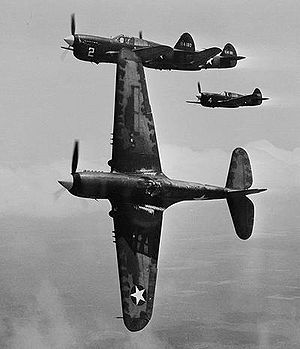
- P-40F and P-40L, which both featured a Packard Merlin engine in place of the normal Allison, and thus did not have the carburetor scoop on top of the nose. Performance for these models at higher altitudes was better than their Allison-engined cousins. The L in some cases also featured a fillet in front of the vertical stabilizer, or a stretched fuselage to compensate for the higher torque. The P-40L was sometimes nicknamed "Gypsy Rose Lee," after a famous stripper of the era, due to its stripped-down condition. Supplied to the Commonwealth air forces under the designation Kittyhawk Mk II, a total of 330 Mk IIs were supplied to the RAF under Lend-Lease. The first 230 aircraft are sometimes known as the Kittyhawk Mk IIA. The P-40F/L was extensively used by US fighter groups operating in the Mediterranian Theater.
- P-40G : 43 P-40 aircraft fitted with the wings of the Tomahawk Mk IIA. 16 aircraft were supplied to the Soviet Union, and the rest to the US Army Air Force. It was later redesignated RP-40G.
- P-40K, an Allison-engined P-40L, with the nosetop scoop retained and the Allison configured scoop and cowl flaps. Supplied to the Commonwealth air forces as the Kittyhawk Mk III, it was widely used by US units in the CBI.
- P-40M, version generally similar to the P-40K, with a stretched fuselage like the P-40L and powered by an Allison V-1710-81 engine giving better performance at altitude (compared to previous Allison versions). It had some detail improvements and it was characterized by two small air scoops just before the exhaust pipes. Most of them were supplied to Allied countries (mainly UK and USSR), while some others remained in the USA for advanced training. It was also supplied to the Commonwealth air forces as the Kittyhawk Mk. III.
- P-40N (manufactured 1943-44), the final production model. The P-40N featured a stretched rear fuselage to counter the torque of the larger, late-war Allison engine, and the rear deck of the cockpit behind the pilot was cut down at a moderate slant to improve rearward visibility. A great deal of work was also done to try and eliminate excess weight to improve the Warhawk's climb rate. Early N production blocks dropped a .50 cal (12.7 mm) gun from each wing, bringing the total back to four; later production blocks reintroduced it after complaints from units in the field. Supplied to Commonwealth air forces as the Kittyhawk Mk IV. A total of 553 P-40Ns were acquired by the Royal Australian Air Force, making it the variant most commonly used by the RAAF. Subvariants of the P-40N ranged widely in specialization from stripped down four-gun hot rods which could reach the highest top speeds of any production variant of the P-40 (up to 378 mph), to overweight types with all the extras intended for fighter-bombing or even training missions.
- P-40P : The designation of 1,500 aircraft ordered with V-1650-1 engines, but actually built as the P-40N with V-1710-81 engines.
- XP-40Q with a 4-bladed prop, cut-down rear fuselage and bubble canopy, supercharger, squared-off wingtips and tail surfaces, and improved engine with two-speed supercharger was tested, but its performance was not enough of an improvement to merit production when compared to the contemporary late model P-47Ds and P-51Ds pouring off production lines. The XP-40Q was, however, the fastest of the P-40 series with a top speed of 422 mph as a result of the introduction of a high-altitude supercharger gear. (No P-40 model with a single-speed supercharger could even approach 400 mph or 640 km/h.) With the end of hostilities in Europe, the P-40 came to the end of its front line service.
- P-40R : The designation of P-40F and P-40L aircraft, converted into training aircraft in 1944.
- RP-40 : Some American P-40s were converted into reconnaissance aircraft.
- TP-40 : Some P-40s were converted into two-seat trainers.
- Twin P-40 : Probably the most unusal variant, it was a P-40C outfitted in 1942 with a pair of 1300 hp (969 kW) V-1650-1 Merlin engines mounted atop the wing, over the main landing gear.[23]
Famous P-40 pilots
- Gregory "Pappy" Boyington: American Volunteer Group (Flying Tigers), Chinese Air Force. (Later leader of the US Marine Corps' "Black Sheep Squadron".)
- Clive "Killer" Caldwell: RAAF, Australia's greatest WW2 ace. (Caldwell scored most of his 28.5 kills while flying Tomahawks in North Africa.)
- Daniel H. David, later known as TV/film comedian/actor Dan Rowan: USAAF, Southwest Pacific theater. Scored two kills against Japanese aircraft before being shot down and seriously wounded.
- James Francis Edwards: RCAF, 22 kills. (He wrote two books about Commonwealth Kittyhawk pilots in World War II.)
- Geoff Fisken: the highest scoring RNZAF and British Commonwealth ace in the Pacific theater. five of his victories were claimed in Kittyhawks.
- John Gorton: RAAF, later Prime Minister of Australia, 1968-71. (Gorton survived two serious crashes. One required him to undergo extensive plastic surgery, with his face being changed significantly as a result. When asked in later life what his most memorable flight had been, Gorton replied: "The one in which I got my face mixed up with the instrument panel of a Kittyhawk.")
- Nikolai F. Kuznetsov: VVS, ace, twice Hero of the Soviet Union. (Most of his 22 kills were scored in the P-40.)
- Petr Pokryshev: VVS, ace, twice Hero of the Soviet Union. (Scored 22 personal victories.)
- Robert Lee Scott, Jr.: Flying Tigers/USAAF, later commander of the U.S. 23rd Fighter Group, in the Fourteenth Air Force. (Scored 10+ kills in the P-40.)
- Len Waters: RAAF, the only Australian Aboriginal fighter pilot of WW2.
Operators
- Template:AUS
- Template:BRA
- Template:CAN
- Template:CHL
 China
China Egypt
Egypt- Template:FIN
- Template:FRA
- Template:NLD
- Template:NZL
 South Africa
South Africa- Template:TUR
- Template:USSR
- Template:UK
 United States
United States
Specifications (P-40E)
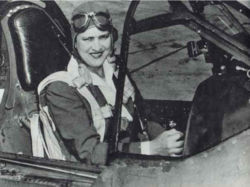
General characteristics
- Crew: 1
- Length: 31 ft 8 in (9.66 m)
- Wingspan: 37 ft 4 in (11.38 m)
- Height: 12 ft 4 in (3.76 m)
- Wing area: 235.94 ft² (21.92 m²)
- Empty weight: 6,350 lb (2,880 kg)
- Loaded weight: 8,280 lb (3,760 kg)
- Max takeoff weight: 8,810 lb (4,000 kg)
- Powerplant: 1× Allison V-1710-39 liquid-cooled V12 engine, 1,150 hp (860 kW)
Performance
- Maximum speed: 360 mph (310 knots, 580 km/h)
- Cruise speed: 270 mph (235 knots, 435 km/h)
- Range: 650 mi (560 nm, 1,100 km)
- Service ceiling: 29,000 ft (8,800 m)
- Rate of climb: 2,100 ft/min (11 m/s)
- Wing loading: 35.1 lb/ft² (171.5 kg/m²)
- Power/mass: 0.14 hp/lb (230 W/kg)
Armament
- Guns: 6× .50 in (12.7 mm) M2 Browning machine guns, 281 rounds per gun
- Bombs: 1,500 lb (680 kg) on three hardpoints
Popular culture
- In the John Wayne movie: Flying Tigers, (1942) real P-40s are featured, along with some inaccurate studio models.
- Ronald Reagan appears in the Identification Of The Japanese Zero (Training Film) (1942) as a young pilot learning to recognize the difference between a P-40 and a Japanese Zero. In this film Reagan mistakes a friend's P-40 for a Japanese Zero and tries to shoot it down. In the end, Reagan gets a chance to shoot down a real Zero.
- In the film, God is My Co-Pilot (1945) about the Flying Tigers and the USAAF pilots who replaced them in the Republic of China and Burma, real P-40s are featured.
- In Tora! Tora! Tora! (1970), P-40s are depicted at the attack on Pearl Harbor, both being shot up on the ground and shooting down Zeros.
- Steven Spielberg's comedy 1941(1979) features a P-40E in the less-than-capable hands of John Belushi's character, "Wild Bill" Kelso.
- Grand Theft Auto San Andreas featured the Curtiss P-40 as a controlable airplane, called a rustler.
- In the film: Pearl Harbor (2001) P-40Es are the main aircraft seen in the film besides Japanese Zeros. Rafe Macauley and Danny Walker fly P-40s during the raid on Pearl Harbor being the only two pilots able to get in the air, recreating the actual event where George Welch and Ken Taylor operated from a satellite field. A P-40N and a P-40E in this movie came from the Warhawk Air Museum in Nampa, Idaho.
- The alternative history/science fiction pastiche, Sky Captain and the World of Tomorrow (2004), has a computer-generated twin-seat fighter aircraft patterned after the P-40 performing amazing feats, including doubling as a submarine, an ability which would have been appreciated by many World War II flyers, had it been possible.
- In the play written by Arthur Miller, All My Sons, Joe Keller and his partner, Steve Deever, knowingly sold cracked cylinder heads to the Army Air Force. As a result, 21 P-40s crashed in Australia. For this, Keller and Deever served time in prison, although Keller was released shortly after when he was found innocent. At the beginning of the play, his partner is still in prison.
References
- ↑ Knaack, Marcelle Size. Encyclopedia of US Air Force Aircraft and Missile Systems: Volume 1 Post-World War II Fighters 1945-1973. Washington, DC: Office of Air Force History, 1978. ISBN 0-912799-59-5.
- ↑ Barass, M. B. (2005-12-02). RAF Timeline 1939 - 1945. Air of Authority - A History of RAF Organisation. Retrieved on 2006-09-04.
- ↑ 3.0 3.1 Hingam, Robin. Flying American Combat Aircraft of WW II. Manhattan, Kansas: Sunflower University Press, 2004. ISBN 0-8117-3124-3. Cite error: Invalid
<ref>tag; name "Flying" defined multiple times with different content - ↑ 4.0 4.1 4.2 4.3 4.4 4.5 4.6 4.7 Masell, Patrick (©2002). The P-40 and the Zero. Naval, Aviation, and Military History. Retrieved on 2006-03-07.
- ↑ 5.0 5.1 5.2 5.3 5.4 Romanenko, Valeriy and Gebhardt, James F. The P-40 in Soviet Aviation. Lend-lease on Airforce.ru [1]Access date: 7 March 2006.
- ↑ 6.0 6.1 6.2 6.3 Thomas, Andrew. Tomahawk and Kittyhawk Aces of the RAF and Commonwealth. London: Osprey Books, 2002. ISBN 1-84176-083-8.
- ↑ Ratuszynski, Wilhelm (1999-03-08). Hans-Joachim Marseille - Desert Eagle. World War II Ace Stories. Retrieved on 2006-03-07.
- ↑ Tate, Major Robert F. (Winter 2001). "[Review of] Desert Warriors: Australian P-40 Pilots at War in the Middle East and North Africa, 1941–1943 by Russell Brown". Aerospace Power Journal. Retrieved on 2006-05-09.
- ↑ Kacha, Petr. Erbo Graf von Kageneck. Aces of the Luftwaffe. Retrieved on 2006-03-27.
- ↑ Dragicevic, George (1999-07-17). Clive "Killer" Caldwell - Stuka Party. Retrieved on 2006-03-07.
- ↑ 11.0 11.1 11.2 Molesworth, Carl. P-40 Warhawk Aces of the CBI. London: Osprey Books, 2000. ISBN 1-84176-079-X.
- ↑ Australias War 1939-1945. Official Australian Government, Department of Veterans Affairs. Retrieved on 2007-01-08.
- ↑ Horn, Alex. Wings Over the Pacific: The RNZAF in the Pacific Air War. Auckland: Random House New Zealand, 1992. ISBN 1-86941-152-8.
- ↑ Mossong, Peter. The Curtiss P-40 in RNZAF Service. Royal New Zealand Air Force Pacific WWII Homepage.
- ↑ Curtiss P-40N Kittyhawk. New Zealand Warbirds Family Album. Retrieved on 2006-09-04.
- ↑ "Official dedication for Old Stick and Rudder company", Wairarapa Times-Age, 2005-01-22.
- ↑ Shilling, Erik. Erik Shilling, AVG Pilot. Retrieved on 2006-03-25.
- ↑ PTO/CBI Pilots of WWII. Acepilots.com (©2005). Retrieved on 2006-03-07.
- ↑ Pike, John (2005-08-21). 23rd Fighter Group Official Website. GlobalSecurity. Retrieved on 2006-09-05.
- ↑ 20.0 20.1 20.2 Molesworth, Carl. P-40 Warhawk Aces of the MTO (Osprey Aircraft of the Aces No 43). London:Osprey Publishing, 2002. ISBN 1-84176-288-1.
- ↑ Cathcart, Carol. 325th Fighter Group: Total Victories by Type of Aircraft. Official 325th Fighter Group WWII "Checkertail Clan" Association. Retrieved on 2006-03-25.
- ↑ Cathcart, Carol. History of the 317th Fighter Squadron. Official 325th Fighter Group WWII "Checkertail Clan" Association. Retrieved on 2006-09-05.
- ↑ Donald, David, ed. Encyclopedia of World Aircraft (Etobicoke, ON: Prospero, 1997), p.291, "Curtiss Model 81/87 (P-40 Warhawk)".
- Bowers, Peter M. and Angellucci, E. The American Fighter. New York: Orion Books, 1987. ISBN 0-517-56588-9.
- Brown, Russell. Desert Warriors: Australian P-40 Pilots at War in the Middle East and North Africa, 1941-1943. Maryborough, Australia: Banner Books, 1983. ISBN 1-875-59322-5.
- Johnsen, F.A. P-40 Warhawk (Warbird History). St. Paul, Minnesota: Motorbooks International, 1999. ISBN 0-7603-0253-7.
- Lavigne, J.P.A. Michel and Edwards, James F. Kittyhawk Pilot. Battleford, Saskatchewan : Turner-Warwick, 1983. ISBN 0-919899-10-2.
- Molesworth, Carl. P-40 Warhawk Aces of the Pacific (Aircraft of the Aces). London: Osprey, 2003. ISBN 1-84176-536-8.
- Scott, Robert L. Damned to Glory. New York: Scribner's, 1944. No ISBN.
- Shores, Christopher and Ring, Hans. Fighters over the Desert. London: Neville Spearman Limited, 1969. ISBN 0-668-02070-9.
External links
- RCAF Kittyhawk - AK803/1034
- Annals of the Flying Tigers
- Curtiss P-40N-CU
- Joe Baugher's American Military Aircraft website
- The P-40 Warhawk
- P-40.com
- The Hawk's Nest - home of the P-40 Warhawk
- Warbird Alley: P-40 page - Information about P-40s still flying today
- P-40 in flight An excellent video on You Tube of a P-40 flying flat out and performing several maneuvers
- Curtiss P-40 Warhawk: One of WW II's Most Famous Fighters A detailed overview of the history of the P-40 on TheHistoryNet.com
Related content
Related development
Comparable aircraft
- P-39 Airacobra
- P-51 Mustang
- A-36 Apache
- Hawker Hurricane
- Lavochkin-Gorbunov-Goudkov LaGG-3
- Kawasaki Ki-61
- Macchi MC.202
- Messerschmitt Bf 109
- Morane-Saulnier M.S.406
- Supermarine Spitfire
- Yakovlev Yak-1
Designation sequence
XP-37 - P-38 - P-39 - P-40 - XP-41 - XP-42 - P-43
Related lists
Lists relating to aviation | |
|---|---|
| General | Timeline of aviation · Aircraft · Aircraft manufacturers · Aircraft engines · Aircraft engine manufacturers · Airports · Airlines |
| Military | Air forces · Aircraft weapons · Missiles · Unmanned aerial vehicles (UAVs) · Experimental aircraft |
| Notable incidents and accidents | Military aviation · Airliners · General aviation · Famous aviation-related deaths |
| Records | Flight airspeed record · Flight distance record · Flight altitude record · Flight endurance record · Most produced aircraft |
| This article is licensed under the GNU Free Documentation License. It uses material from the Wikipedia article "P-40 Warhawk". |
